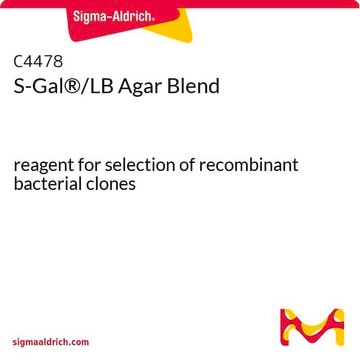S7313
S-Gal® sodium salt
reagent for selection of recombinant bacterial clones
Sinónimos:
3,4-Cyclohexeneoesculetin-B-D-galactopyranoside sodium salt
About This Item
Productos recomendados
grade
for molecular biology
sterility
non-sterile
assay
≥95% (HPLC)
form
powder
IVD
not for in vitro diagnostic use
solubility
H2O: 100 mg/mL
suitability
suitable for β-galactosidase test
storage temp.
room temp
General description
Application
Features and Benefits
- More intense color contrast than X-gal
- Water-soluble and autoclavable for easiest use
- Excellent for use in automated colony counters
- No need to make stock solutions
Other Notes
formulation. A medium prepared with S-Gal® is moderately dark due to the presence of ferric ammonium citrate. This darker background often provides enhanced contrast for automated colony counting or isolation.
Caution
Principle
Linkage
Reconstitution
Legal Information
related product
Storage Class
11 - Combustible Solids
wgk_germany
WGK 3
flash_point_f
Not applicable
flash_point_c
Not applicable
ppe
Eyeshields, Gloves, type N95 (US)
Certificados de análisis (COA)
Busque Certificados de análisis (COA) introduciendo el número de lote del producto. Los números de lote se encuentran en la etiqueta del producto después de las palabras «Lot» o «Batch»
¿Ya tiene este producto?
Encuentre la documentación para los productos que ha comprado recientemente en la Biblioteca de documentos.
Los clientes también vieron
Nuestro equipo de científicos tiene experiencia en todas las áreas de investigación: Ciencias de la vida, Ciencia de los materiales, Síntesis química, Cromatografía, Analítica y muchas otras.
Póngase en contacto con el Servicio técnico







